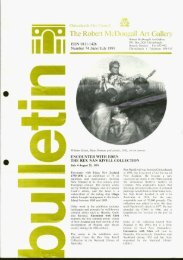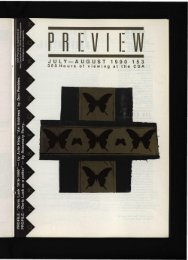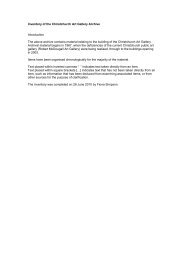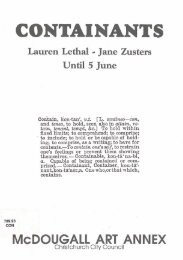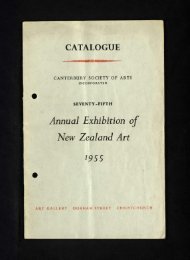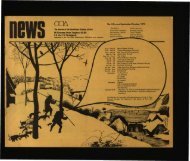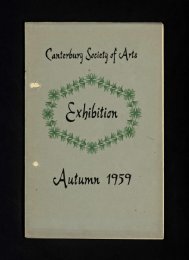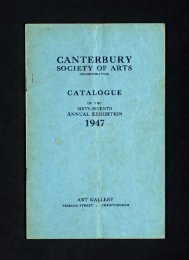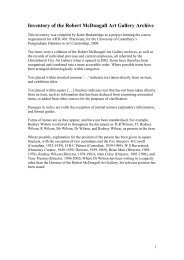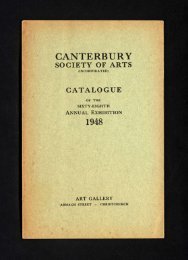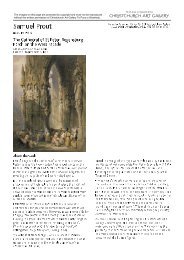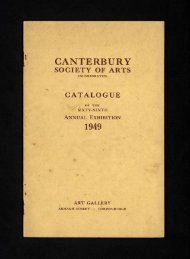Download - Christchurch Art Gallery
Download - Christchurch Art Gallery
Download - Christchurch Art Gallery
Create successful ePaper yourself
Turn your PDF publications into a flip-book with our unique Google optimized e-Paper software.
PULSE<br />
DARRYN GEORGE<br />
OPENS 8 MARCH<br />
Waru 2008 oil on canvas. Courtesy of the artist and Gow Langsford <strong>Gallery</strong><br />
Darryn George’s latest artwork looks engulfing, even on a<br />
screen thirty centimetres high. On the laptop in the no-fuss<br />
studio behind his home in suburban Strowan, George is<br />
flipping through working designs for his artist’s project<br />
Pulse. With each double-click, the hard drive whirs and<br />
another wall-full of pattern leaps into view. Click: red lines<br />
sizzling from floor to ceiling. Click: white forms floating in<br />
a deep field of black. Click: blocky shapes locked massively<br />
together, like a word-puzzle for giants.<br />
Cut now to the Sutton <strong>Gallery</strong> on <strong>Christchurch</strong> <strong>Art</strong><br />
<strong>Gallery</strong>’s ground floor, where an exhibition has just come<br />
down and George is pacing out the long walls and warily<br />
eyeing the five-metre-high ceiling. Seen like this, with no<br />
art on the walls, the Sutton is a classic ‘white cube’ gallery<br />
– colourless, cool and hushed. But when the signwriters<br />
move in here with final designs in hand, it will become<br />
anything but silent. George’s plan: to power up the space<br />
with a continual pulse of language and pattern.<br />
The plan began to grow when George started paying<br />
attention to something ordinarily ignored in the Sutton<br />
<strong>Gallery</strong>: the large pillar at its centre. For most viewers the<br />
pillar is simply something to get past before getting a full<br />
view of the walls, but George had good reason to give this<br />
obstacle a second look.<br />
In his abstract paintings of the past five or so years,<br />
George has often alluded to the physical structure of Mori<br />
wharenui – the ‘big houses’ wherein rafters and centre poles<br />
represent the ribs and backbones of ancestors. And here in<br />
the Sutton <strong>Gallery</strong>, it seemed to George, was an unnoticed<br />
centre pole just waiting to be activated by a coat of colour<br />
and pattern. So, turning what first looked like an obstacle<br />
into a prompt and inspiration, George began to spin his<br />
designs from the centre pole out to the walls. Fusing the<br />
wharenui idea with the clean hard look of modern abstract<br />
art, he’s creating a ‘big house’ within the house that is the<br />
<strong>Gallery</strong> – a decorative environment reaching from floor to<br />
ceiling and all the way around.<br />
If that word ‘decorative’ sounds a little dismissive to<br />
you, then there’s no better time to visit the <strong>Gallery</strong> and<br />
have your assumptions turned around. Like the work of<br />
William Morris (showing directly across from Pulse), and<br />
like Richard Killeen’s eye-popping mural on the exterior wall<br />
of the <strong>Gallery</strong>, George’s paintings spring from a belief in the<br />
power and cultural force of pattern – a faith that decorative<br />
forms carry as much cultural voltage, speak as powerfully,<br />
as any other kind of imagery.<br />
That faith is literally writ large in George’s design for<br />
the end wall, where he blocks together an enormous pattern<br />
from the elements of the word waru. In meeting houses,<br />
people often stand, sing and speak in front of the end wall,<br />
spiritually supported from behind by carvings or photos of<br />
ancestors. In George’s wordscape, the wall itself seems to<br />
be speaking, sounding out every possible variation on the<br />
word waru, which means eight and, for George, evokes a<br />
spiritual time and space beyond the seven days of the week.<br />
Though these words will in the end tower above viewers,<br />
their effect in George’s on-screen drawings is not domineering<br />
but dynamic, as if he’s still testing the fit between different<br />
pieces of the puzzle.<br />
For we viewers, one further piece of the puzzle is the<br />
show’s title, Pulse. Perhaps it refers to the lines of white<br />
punctuating the side walls of George’s virtual house – a<br />
steady beat of light. Or perhaps it refers to the exhibition<br />
as a whole, one pulse in a larger cycle of exhibitions. But<br />
it also seems to take up something quite new in George’s<br />
work, namely the lines and bands of deep, humming purple<br />
that course through sections of his design, only to disappear<br />
and reappear farther on.<br />
Looking at the laptop images, you might think of electricity<br />
flowing through circuits, or routes marked in glowing colour<br />
on a digital map. But when those lines go from screen to wall<br />
they’ll suggest a pulse that is larger in every sense – lifeblood<br />
flowing through the body of the building.<br />
Justin Paton<br />
Senior curator<br />
Darryn George: Pulse opens in the William A. Sutton <strong>Gallery</strong><br />
on 8 March.<br />
Pulse<br />
Sunday 27 April, 1 pm<br />
Join artist Darryn George for a floortalk in his exhibition.<br />
36 37



